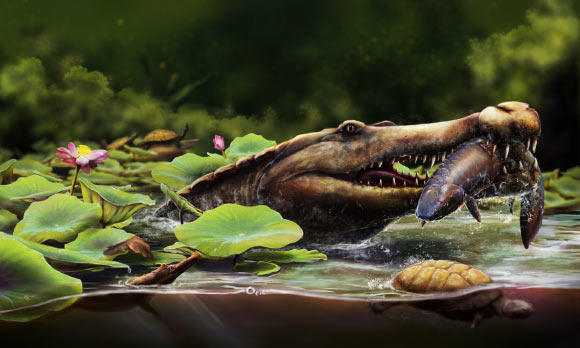Paleontologists have discovered two partial skulls and three partial jaws from an early-diverging dyrosaurid crocodyliform in the layers of the Quseir Formation in Egypt.
The new crocodyliform species lived in what is now Egypt about 80 million years ago (Late Cretaceous epoch).
Named Wadisuchus kassabi, it was a type of dyrosaurid, a group of crocodyliforms characterized by diverse skull morphologies and a broad distribution from the Late Cretaceous to the Paleogene.
“Unlike today’s crocodiles, dyrosaurids thrived in coastal and marine environments, equipped with elongated snouts and slender, needle-sharp teeth ideal for seizing slippery prey such as fish and turtles,” said Assiut University paleontologist Sara Saber and colleagues.
“Their remarkable survival and dispersal after the extinction of the dinosaurs make them crucial for understanding how reptiles adapted and diversified when global ecosystems collapsed.”
Wadisuchus kassabi measured between 3.5 and 4 m, had a very long snout and tall, sharp teeth.
“It differed from other dyrosaurids, in having four teeth at the front of the snout instead of the primitive five, nostrils positioned on top of the snout for surface breathing, and a deep notch at the tip of the snout where the jaws met,” Dr. Saber said.
“These features show a gradual adaptation in the dyrosaurid bite, marking an important step in their evolutionary history.”
Two partial skulls and three partial jaws from four Wadisuchus kassabi individuals were discovered at Kharga and Baris oases in Egypt’s Western Desert.
“Beyond the distinctive features of Wadisuchus kassabi, it plays a crucial role in understanding the origin of the dyrosaurid group,” Dr. Saber said.
“The new species pushes back evidence for an African origin of Dyrosauridae and suggests that their diversification began earlier than previously thought — possibly during the Early Coniacian-Santonian (about 87-83 million years ago), rather than the traditionally assumed Maastrichtian (about 72-66 million years ago).”
“This discovery indicates that Africa was the cradle of dyrosaurid evolution, from which later lineages spread across the globe and our phylogenetic analyses consistently place Wadisuchus kassabi an ancestor of the dyrosaurid group,” said Belal Salem, a researcher at Mansoura University, Ohio University and Benha University.
“The significance of Wadisuchus kassabi lies not only in what it reveals about the evolutionary history of this remarkable group of crocodiles — though that is a major achievement — but also in what it reminds us of: Egypt’s Western Desert still holds treasures that preserve the secrets of our planet’s deep past.”
The study was published today in the Zoological Journal of the Linnean Society.
_____
Sara Saber et al. 2025. An early dyrosaurid (Wadisuchus kassabi gen. et sp. nov.) from the Campanian of Egypt sheds light on the origin and biogeography of Dyrosauridae. Zoological Journal of the Linnean Society 205 (2): zlaf134; doi: 10.1093/zoolinnean/zlaf134








